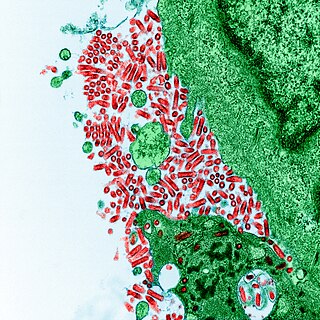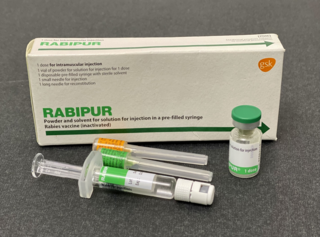Related Research Articles

Rabies virus, scientific name Rabies lyssavirus, is a neurotropic virus that causes rabies in animals, including humans. Rabies transmission can occur through the saliva of animals and less commonly through contact with human saliva. Rabies lyssavirus, like many rhabdoviruses, has an extremely wide host range. In the wild it has been found infecting many mammalian species, while in the laboratory it has been found that birds can be infected, as well as cell cultures from mammals, birds, reptiles and insects. Rabies is reported in more than 150 countries and on all continents except Antarctica. The main burden of disease is reported in Asia and Africa, but some cases have been reported also in Europe in the past 10 years, especially in returning travellers.

The big brown bat is a species of vesper bat distributed widely throughout North America, the Caribbean, and the northern portion of South America. It was first described as a species in 1796. Compared to other microbats, the big brown bat is relatively large, weighing 15–26 g (0.53–0.92 oz) and possessing a wingspan of 32.5–35 cm (12.8–13.8 in).
Mokola lyssavirus, commonly called Mokola virus (MOKV), is an RNA virus related to rabies virus that has been sporadically isolated from mammals across sub-Saharan Africa. The majority of isolates have come from domestic cats exhibiting symptoms characteristically associated to rabies virus infection.
Lagos bat lyssavirus, formerly Lagos bat virus (LBV) is a Lyssavirus of southern and central Africa that causes a rabies-like illness in mammals. It was first isolated from a fruit bat from Lagos Island, Nigeria in 1956. Brain samples from the bat showed poor cross-reactivity to rabies antibodies but the virus was found to be closely related to the rabies virus. This was the first discovery of a rabies-related virus. Until this time, rabies was thought to have a single causal agent.
Duvenhage lyssavirus (DUVV) is a member of the genus Lyssavirus, which also contains the rabies virus. The virus was discovered in 1970, when a South African farmer died of a rabies-like encephalitic illness, after being bitten by a bat. In 2006, Duvenhage virus killed a second person, when a man was scratched by a bat in North West Province, South Africa, 80 km from the 1970 infection. He developed a rabies-like illness 27 days after the bat encounter, and died 14 days after the onset of illness. A 34-year-old woman who died in Amsterdam on December 8, 2007, was the third recorded fatality. She had been scratched on the nose by a small bat while travelling through Kenya in October 2007, and was admitted to hospital four weeks later with rabies-like symptoms.

Ake is an archaeological site of the pre-Columbian Maya civilization. It is located in the municipality of Tixkokob, in the Mexican state of Yucatán; 40 km (25 mi) east of Mérida, Yucatán.

Ferret-badgers are the six species of the genus Melogale, which is the only genus of the monotypic mustelid subfamily Helictidinae.
In Greek mythology, Lyssa, called Lytta by the Athenians, was the spirit of mad rage, frenzy, and rabies in animals. She was closely related to the Maniae, the spirits of madness and insanity. Her Roman equivalent was variously named Ira, Furor, or Rabies. Sometimes she was multiplied into a host of Irae and Furores.

Åke Fridell was a Swedish film actor. He was born in Gävle, Sweden and died in Stockholm.
The Image Makers is a 2000 Swedish television play directed by Ingmar Bergman and written by Per Olov Enquist. The drama is set in the year 1920 at Filmstaden where the film director Victor Sjöström is shooting the film The Phantom Carriage, an adaptation of Selma Lagerlöf's novel Thy Soul Shall Bear Witness! Accompanied by actress Tora Teje and film photographer Julius Jaenzon, he has now invited the book's author to take a first look at some early scenes.

The rabies vaccine is a vaccine used to prevent rabies. There are several rabies vaccines available that are both safe and effective. Vaccinations must be administered prior to rabies virus exposure or within the latent period after exposure to prevent the disease. Transmission of rabies virus to humans typically occurs through a bite or scratch from an infectious animal, but exposure can occur through indirect contact with the saliva from an infectious individual.

Rabies is a viral disease that causes encephalitis in humans and other mammals. It was historically referred to as hydrophobia due to the symptom of panic when presented with liquids to drink. Early symptoms can include fever and abnormal sensations at the site of exposure. These symptoms are followed by one or more of the following symptoms: nausea, vomiting, violent movements, uncontrolled excitement, fear of water, an inability to move parts of the body, confusion, and loss of consciousness. Once symptoms appear, the result is virtually always death, regardless of treatment. The time period between contracting the disease and the start of symptoms is usually one to three months but can vary from less than one week to more than one year. The time depends on the distance the virus must travel along peripheral nerves to reach the central nervous system.

In animals, rabies is a viral zoonotic neuroinvasive disease which causes inflammation in the brain and is usually fatal. Rabies, caused by the rabies virus, primarily infects mammals. In the laboratory it has been found that birds can be infected, as well as cell cultures from birds, reptiles and insects. The brains of animals with rabies deteriorate. As a result, they tend to behave bizarrely and often aggressively, increasing the chances that they will bite another animal or a person and transmit the disease.
Rafivirumab (CR57) is a monoclonal antibody for the prophylaxis of rabies.
Mr. Sleeman Is Coming is a 1917 one-act play by the Swedish author Hjalmar Bergman. The main character is an orphaned young woman who is about to be married off to an unappealing but rich old man, Mr. Sleeman, at the instigation of her aunts who have taken charge of her. Bergman infuses the situation with overtones of rueful pessimism concerning life in general.
Wilson Asinobi Ake is a former member of the Senate of Nigeria who represented the Rivers West senatorial district from 2007 to 2015. He is a member of the People's Democratic Party (PDP).
Ake (Aike) is a Plateau language of Nigeria. It is spoken in three villages near Akwanga.
Åke and His World is a 1984 Swedish drama film directed by Allan Edwall. It was entered into the 14th Moscow International Film Festival. The film was also selected as the Swedish entry for the Best Foreign Language Film at the 57th Academy Awards, but was not accepted as a nominee.

Rabies is a 2010 Israeli film written and directed by Aharon Keshales and Navot Papushado. It was marketed as "the first feature-length Israeli horror film".
Institut Pasteur du Cambodge is a medical research centre and public health institute in Phnom Penh, Cambodia. It is part of the Pasteur Institute's international network of health centres and is partnered with the Ministry of Health. It was first established in 1953 and reopened in 1992 after the 1991 Paris Peace Agreements.
References
- ↑ "Bergmanorama: Rabies". Bergmanorama. Archived from the original on 3 December 2008. Retrieved 22 April 2009.